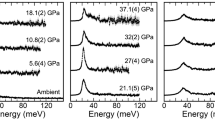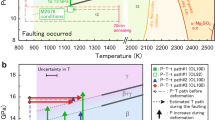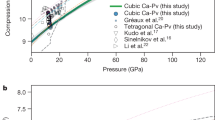Abstract
Lateral variations of seismic wave speeds and attenuation (dissipation of strain energy) in the Earth’s upper mantle have the potential to map key characteristics such as temperature, major-element composition, melt fraction and water content1,2,3. The inversion of these data into meaningful representations of physical properties requires a robust understanding of the micromechanical processes that affect the propagation of seismic waves2,3. Structurally bound water (hydroxyl) is believed to affect seismic properties2,3 but this has yet to be experimentally quantified. Here we present a comprehensive low-frequency forced-oscillation assessment of the seismic properties of olivine as a function of water content within the under-saturated regime that is relevant to the Earth’s interior. Our results demonstrate that wave speeds and attenuation are in fact strikingly insensitive to water content. Rather, the redox conditions imposed by the choice of metal sleeving, and the associated defect chemistry, appear to have a substantial influence on the seismic properties. These findings suggest that elevated water contents are not responsible for low-velocity or high-attenuation structures in the upper mantle. Instead, the high attenuation observed in hydrous and oxidized regions of the upper mantle (such as above subduction zones) may reflect the prevailing oxygen fugacity. In addition, these data provide no support for the hypothesis whereby a sharp lithosphere–asthenosphere boundary is explained by enhanced grain boundary sliding in the presence of water.
This is a preview of subscription content, access via your institution
Access options
Access Nature and 54 other Nature Portfolio journals
Get Nature+, our best-value online-access subscription
$29.99 / 30 days
cancel any time
Subscribe to this journal
Receive 51 print issues and online access
$199.00 per year
only $3.90 per issue
Buy this article
- Purchase on Springer Link
- Instant access to full article PDF
Prices may be subject to local taxes which are calculated during checkout


 for different capsule materials and several representative oscillation periods.
for different capsule materials and several representative oscillation periods.
 .
.

Similar content being viewed by others
References
Romanowicz, B. A. & Mitchell, B. J. in Treatise on Geophysics 2nd edn, 789–827 (Elsevier, 2015)
Karato, S. Mapping water content in upper mantle. In Inside the Subduction Factory Vol. 138, 135–152 (Geophysical Monograph Series, AGU, 2003)
Abers, G . et al. Reconciling mantle attenuation-temperature relationships from seismology, petrology, and laboratory measurements. Geochem. Geophys. 15, 3521–3542 (2014)
Jacobsen, S. D . et al. Effects of hydration on the elastic properties of olivine. Geophys. Res. Lett. 35, L14303 (2008)
Jackson, I. in Treatise on Geophysics 2nd edn, 539–571 (Elsevier, 2015)
Farla, R. J ., Jackson, I ., Fitz Gerald, J. D ., Faul, U. H. & Zimmerman, M. E. Dislocation damping and anisotropic seismic wave attenuation in Earth’s upper mantle. Science 336, 332–335 (2012)
Bai, Q ., Mackwell, S. J. & Kohlstedt, D. L. High-temperature creep of olivine single crystals 1. Mechanical results for buffered samples. J. Geophys. Res. 96, 2441 (1991)
Karato, S.-I. & Jung, H. Effects of pressure on high-temperature dislocation creep in olivine. Phil. Mag. 83, 401–414 (2003)
Mei, S. & Kohlstedt, D. Influence of water on plastic deformation of olivine aggregates. 2. Diffusion creep regime. J. Geophys. Res. 105, 21457–21469 (2000)
Karato, S.-I. On the origin of the asthenosphere. Earth Planet. Sci. Lett. 321/322, 95–103 (2012)
Olugboji, T. M ., Karato, S-I . & Park, J. Structures of the oceanic lithosphere-asthenosphere boundary: mineral-physics modeling and seismological signatures. Geochem. Geophys. 14, 880–901 (2012)
Aizawa, Y . et al. Seismic properties of Anita Bay dunite: an exploratory study of the influence of water. J. Petrol. 49, 841–855 (2008)
Faul, U. H., Cline, C. J. II, David, E. C., Berry, A. J. & Jackson, I. Titanium-hydroxyl defect-controlled rheology of the Earth’s upper mantle. Earth Planet. Sci. Lett. 452, 227–237 (2016)
Berry, A. J ., Hermann, J ., O’Neill, H. S. C. & Foran, G. J. Fingerprinting the water site in mantle olivine. Geology 33, 869 (2005)
Walker, A. M ., Hermann, J ., Berry, A. J. & O’Neill, H. S. C. Three water sites in upper mantle olivine and the role of titanium in the water weakening mechanism. J. Geophys. Res. 112, B05211 (2007)
Kovács, I ., O’Neill, H. S. C ., Hermann, J. & Hauri, H. Site-specific infrared OH absorption coefficients for water substitution into olivine. Am. Mineral. 95, 292–299 (2010)
Jackson, I . & Faul, U. H. Grainsize-sensitive viscoelastic relaxation in olivine: Towards a robust laboratory-based model for seismological application. Phys. Earth Planet. Inter. 183, 151–163 (2010)
De Hoog, J ., Gail, L . & Cornell, D. Trace-element geochemistry of mantle olivine and application to mantle petrogenesis and geothermobarometry. Chem. Geol. 270, 196–215 (2010)
Nakamura, A. & Schmalzried, H. On the nonstoichiometry and point defects of olivine. Phys. Chem. Mineral. 10, 27–37 (1983)
Dohmen, R. & Chakraborty, S. Fe–Mg diffusion in olivine II: point defect chemistry, change of diffusion mechanisms and a model for calculation of diffusion coefficients in natural olivine. Phys. Chem. Mineral. 34, 409–430 (2007)
Lin, P.-Y. P . et al. High-resolution seismic constraints on flow dynamics in the oceanic asthenosphere. Nature 535, 538–541 (2016)
Shimizu, K . et al. Two-component mantle melting-mixing model for the generation of mid-ocean ridge basalts: implications for the volatile content of the Pacific upper mantle. Geochim. Cosmochim. Acta 176, 44–80 (2016)
Hirth, G. & Kohlstedt, D. L. Water in the oceanic upper mantle: implications for rheology, melt extraction and the evolution of the lithosphere. Earth Planet. Sci. Lett. 144, 93–108 (1996)
Tenner, T. J ., Hirschmann, M. M ., Withers, A. C. & Ardia, P. H2O storage capacity of olivine and low-Ca pyroxene from 10 to 13 GPa: consequences for dehydration melting above the transition zone. Contrib. Mineral. Petrol. 163, 297–316 (2012)
Sarafian, E . et al. The electrical structure of the central Pacific upper mantle constrained by the NoMelt experiment. Geochem. Geophys. 16, 1115–1132 (2015)
Stachnik, J. C ., Abers, G. A. & Christensen, D. H. Seismic attenuation and mantle wedge temperatures in the Alaska subduction zone. J. Geophys. Res. 109, B10304 (2004)
Kelley, K. A. & Cottrell, E. Water and the oxidation state of subduction zone magmas. Science 325, 605–607 (2009)
Brounce, M. N ., Kelley, K. A. & Cottrell, E. Variations in Fe3+/ΣFe of Mariana arc basalts and mantle wedge fO2 . J. Petrol. 55, 2513–2536 (2014)
McCammon, C. A . et al. Oxidation state of iron in hydrous mantle phases: implications for subduction and mantle oxygen fugacity. Phys. Earth Planet. Inter. 143–144, 157–169 (2004)
Faul, U. H., Cline, C. J. II, Berry, A., Jackson, I. & Garapić, G. Constraints on oxygen fugacity within metal capsules. Phys. Chem. Mineral. https://doi.org/10.1007/s00269-017-0937-7 (2017)
Jackson, I. et al. Grain-size-sensitive seismic wave attenuation in polycrystalline olivine. J. Geophys. Res. 107, 2360 (2002)
Tan, B. H., Jackson, I. & Fitz Gerald, J. D. High-temperature viscoelasticity of fine-grained polycrystalline olivine. Phys. Chem. Miner. 28, 641–664 (2001)
Jackson, I. & Paterson, M. S. A high pressure, high temperature apparatus for studies of seismic wave dispersion and attenuation. Pure Appl. Geophys. 141, 445–466 (1993)
Jackson, I., Barnhoorn, A., Aizawa, Y. & Saint, C. Improved procedures for the laboratory study of high-temperature viscoelastic relaxation. Phys. Earth Planet. Inter. 172, 104–115 (2009)
Engi, M. & Lindsley, D. H. Stability of titanian clinohumite: Experiments and thermodynamic analysis. Contrib. Mineral. Petrol. 72, 415–424 (1980)
Kessel, R., Beckett, J. R. & Stolper, E. M. Thermodynamic properties of the Pt-Fe system. Am. Mineral. 86, 1003–1014 (2001)
Rubie, D. C., Karato, S., Yan, H. & O’Neill, H. S. C. Low differential stress and controlled chemical environment in multianvil high-pressure experiments. Phys. Chem. Mineral. 20, 315–322 (1993)
Heald, E. Thermodynamics of iron-platinum alloys. Trans. Metal. Soc. AIME 239, 1337–1340 (1967)
Paterson, M. The thermodynamics of water in quartz. Phys. Chem. Mineral. 13, 245–255 (1986)
Acknowledgements
We thank H. Kokkonen and H. Miller for technical support with sample preparation and operation of the Australian National University rock physics laboratory, H. Chen for assistance with electron backscatter diffraction, and S. Karato of Yale University for suggestions that improved the manuscript. This work was supported by grant DP130103848 from the Australian Research Council to I.J., A.J.B., U.H.F. and S. Karato. U.H.F. acknowledges support from NSF grant EAR 1321889. C.J.C. gratefully acknowledges funding by an Australian National University International PhD Research Scholarship.
Author information
Authors and Affiliations
Contributions
C.J.C. conducted the forced-oscillation measurements (with contributions from E.C.D.). C.J.C. obtained the microstructural and spectroscopic data, subsequently interpreted by U.H.F., E.C.D., I.J., A.J.B. and C.J.C.  and Fe3+ calculations were performed by U.H.F. The manuscript was written by C.J.C. with contributing revisions and discussion from all authors.
and Fe3+ calculations were performed by U.H.F. The manuscript was written by C.J.C. with contributing revisions and discussion from all authors.
Corresponding author
Ethics declarations
Competing interests
The authors declare no competing financial interests.
Additional information
Reviewer Information Nature thanks G. Abers and T. Irifune for their contribution to the peer review of this work.
Publisher's note: Springer Nature remains neutral with regard to jurisdictional claims in published maps and institutional affiliations.
Extended data figures and tables
Extended Data Figure 1 Electron back-scatter diffraction map of sample 1623 (0.5[Ti]) after mechanical testing, coloured to indicate different crystallographic orientations.
A near-‘foam’ microstructure is present, with apparent grain-boundary serrations being an artefact of the post-processing grain boundary reconstruction using MTEX software (http://mtex-toolbox.github.io/).
Rights and permissions
About this article
Cite this article
Cline II, C., Faul, U., David, E. et al. Redox-influenced seismic properties of upper-mantle olivine. Nature 555, 355–358 (2018). https://doi.org/10.1038/nature25764
Received:
Accepted:
Published:
Issue Date:
DOI: https://doi.org/10.1038/nature25764
This article is cited by
-
Redox geodynamics in Earth’s interior
Science China Earth Sciences (2022)
-
Modelling hydrogen mobility in forsterite as diffusion coupled to inter-site reaction
Contributions to Mineralogy and Petrology (2022)
-
Partitioning of Fe2O3 in peridotite partial melting experiments over a range of oxygen fugacities elucidates ferric iron systematics in mid-ocean ridge basalts and ferric iron content of the upper mantle
Contributions to Mineralogy and Petrology (2021)
-
Intraplate volcanism originating from upwelling hydrous mantle transition zone
Nature (2020)
-
Seismic evidence for partial melt below tectonic plates
Nature (2020)
Comments
By submitting a comment you agree to abide by our Terms and Community Guidelines. If you find something abusive or that does not comply with our terms or guidelines please flag it as inappropriate.



